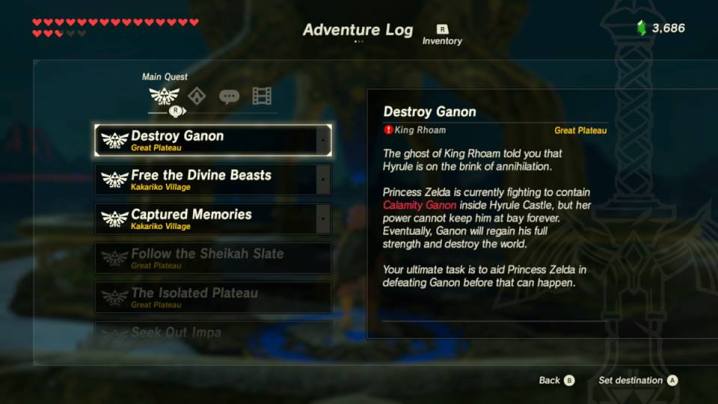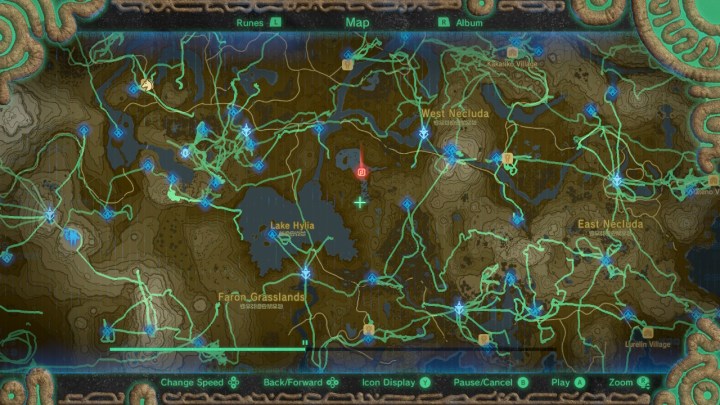The Legend of Zelda: Breath of the Wild is the most open-ended game in the series since the original Legend of Zelda over 20 years ago. That game handed you a sword and told you, essentially, “good luck.” Breath of the Wild quickly gives you a multitude of tools, from bombs to a paraglider, but the message is effectively the same.
It can be easy to get lost in this dazzlingly expansive new version of Hyrule. Sometimes it can feel like the game is purposely withholding information — like you could get where you needed to go, if only it would tell you where that is. And especially early on, you might just feel totally lost and unable to figure out what to do next. With dozen of hours of the game under our belt, we’ve experienced this feeling, and we can tell you that, no matter how confusing it seems, you can always find your way.
Here are some tips for how to find your path forward.
Recommended reading:
- Everything we know about Breath of the Wild 2
- The best armor in BOTW, and where to find it
- The best weapons in BOTW, and where to find them
Make sure you have the right quest selected

There’s a point in Breath of the Wild, just after you get to Kakariko Village, in which the game basically tricks you into getting lost. After you speak to Impa you receive two new main quests. One is what you should do next, while the other is a much longer-term goal. Yet that’s the one it selects for you, which leads many players to feel like there’s no obvious place for them to go next.
It’s not a nice trick, but it will hopefully teach you a lesson: Use the quest menu. Even if the game hasn’t selected the wrong quest for you, sometimes looking at where you’re going can help your goals feel more attainable.
To look at the quest menu, go to the inventory menu by pressing the + button, and press left. The quest menu lets you flick between main story, side and shrine quests with the right analog stick. The one you have selected will put an objective marker on your map and in-game radar. It might not tell you exactly where to go, but it will be in the right ballpark.
Be OK with being lost

The Legend of Zelda: Breath of the Wild’s story is about Link waking up after 100 years and reclaiming Hyrule from Calamity Canon. But the story of the game — of you playing the game — is about going on an adventure. And part of going on an adventure is getting lost.
Set out into the unknown. Find a high vantage point and just look around. You’re guaranteed to see something that piques your interest, whether it’s a distant shrine, a mysterious island, or a massive dragon flying through the sky. Then go there. You might get lost, and it might feel like you’re not making progress. But you can always fast travel back to the known world — your comfort zone — and if nothing else you’ve gained experiences. Those count for a lot in Breath of the Wild.
Always be prepared

There are lots of potential barriers to making progress in this game. Even if you spot a map tower or a shrine in the distance you want to reach, you might fail to get there. Maybe the weather turned incredibly hot, or you ran headlong into a huge enemy you couldn’t hope to defeat. Maybe — and this happened to us — you fought your way to a far-off tower only to find you don’t have enough stamina to climb it.
That’s on you! Prepare for the unexpected and you won’t feel so helpless. Experiment with a cook pot (and read our cooking guide). Make cooling meals and potions so you can withstand the heat, grind out some rupees to buy the stealth gear in Kakariko so you can avoid tough enemies, and always — always — carry several stamina-boosting items with you. Stamella shrooms and restless crickets are some of the most common ingredients in the game. Or you can even use amiibo to spawn nearly every food type in the game.
Talk to everyone

If you’re looking for somewhere to go or something to do, try simply talking to people. Almost every single person you can converse with will offer something — even if they don’t have the little red icon that indicates they’ll give you a side quest, they might mention a nearby fairy fountain or give you hints about how to proceed.
Impa and other characters around Kakariko will give you plenty of additional information after you get the main quest from her, for example, while a painter who pops up all around Hyrule will help you with that pesky photo quest. Almost everything in Breath of the Wild exists for a reason, including every random person you might meet.
Use common sense

You can’t get to Death Mountain because your clothes light on fire every time you get close? Think about it from this angle: where might they sell something that could help travelers on their way to Death Mountain? Are there any logical points a traveler might stop and rest before entering fire country? Something like a stable?
Logic and common sense go a long way in Breath of the Wild. There isn’t a single environment in this game that’s closed off to you based on story progress, so if you want to go there, you can. You just need to figure out how. The game gives you the tools you need to reach those points and it’s up to you to find and use them effectively.
Use the map to keep track of where you’ve been

Breath of the Wild’s map is incredibly dynamic, yet it’s simple to use. It includes several features designed to assist you in keeping track of where you’ve been — as well as where you should go next. Using Hero’s Path will keep a history of precisely what route you’ve taken (up to 200 hours worth), pointing out all the places you have skipped so far. The image you see above shows a save with 150+ hours of playtime, yet there are still spots we missed. Additionally, you’ll want to get your use out of the map’s stamps. If you spot an area that strikes you but you are uncertain how to get there yet, just place a stamp on the area as a reminder for you to return.
Pick something — anything — to do

Breath of the Wild has no shortage of potential gameplay options. It features an open-world style of play that can leave some players feeling overwhelmed about their next decisions. There seem to be limitless actions you can take, between the side quests, shrines to explore, and dungeons to pillage.
If you feel a bit overwhelmed by your list of possible next moves, we recommend writing down your possible next tasks and organizing them in a way that best makes sense to you. Label each task in terms of importance or based on how much you know about that particular task. After you’ve listed everything out, it can feel easier to make a logical plan. Then, you can start tackling the list and having fun with it.
If you’re a player who perseveres and plays with a lot of heart, you’ll find that you can see real progress throughout your game by using the steps previously mentioned. One of our favorite things about Breath of the Wild is that you’ll never stop finding fun activities to try. Don’t feel bogged down by the number of actions you have to take; Tackle your personal goals one by one, and eventually, you’ll start knocking off the prime game goals too.
Editors' Recommendations
- Best Nintendo Switch deals: consoles, games, and accessories
- The best horses in The Legend of Zelda: Breath of the Wild
- Can you play the Nintendo Switch Lite on a TV?
- The Legend of Zelda: Tears of the Kingdom DLC is not happening, says Nintendo
- The best Legend of Zelda: Tears of the Kingdom mods


